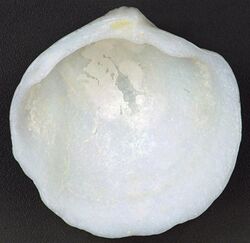Biology:Lucina pensylvanica
| Lucina pensylvanica | |
|---|---|

| |
| Lucina pensylvanica shell | |
| Scientific classification | |
| Domain: | Eukaryota |
| Kingdom: | Animalia |
| Phylum: | Mollusca |
| Class: | Bivalvia |
| Order: | Lucinida |
| Superfamily: | Lucinoidea |
| Family: | Lucinidae |
| Genus: | Lucina |
| Species: | L. pensylvanica
|
| Binomial name | |
| Lucina pensylvanica | |
| Synonyms[1] | |
| |
Lucina pensylvanica, commonly known as the Pennsylvania lucine,[2] is a species of bivalve mollusc in the family Lucinidae.
Taxonomy
This mollusc was first described in 1758 by the Swedish naturalist Carl Linnaeus, who gave it the name Venus pensylvanica. He spelt the specific name incorrectly, with only a single "n" in the first syllable, but by the law of priority laid down in the International Code of Zoological Nomenclature, the original spelling is retained even if it contained an error. The mollusc has since been reassigned to the genus Lucina, becoming Lucina pensylvanica.[2]
Description
Lucina pensylvanica is nearly circular in shape and grows to a maximum size of about 50 mm (2 in). There is a marked groove on the posterior side of the valves and the concentric sculpturing is somewhat irregular. The valves are largely white, but remnants of the brownish periostracum may remain in the form of calcified scales.[3] These scales contain calcareous granules and have a thin layer of prismatic aragonite on their ventral surfaces, which gives an unusual flexibility to the margin of the valve.[4]
Distribution
Found along the Atlantic coast of North America, ranging from North Carolina to the West Indies.[5]
Ecology
Like other members of the Lucinidae, Lucina pensylvanica possesses chemosymbiotic, sulphur-oxidizing bacteria housed in bacteriocytes in their gills.[6] During periods of starvation in the laboratory, researchers found that Lucina pensylvanica preserved the bacterial symbionts for three months or more, continuing to obtain nutrients from the bacteria which continued their sulphur-oxidizing activities, relying on sulphur stored by the host in granules. This was in contrast to the dwarf tiger lucine Ctena orbiculata which did not retain its symbiotic bacteria during a period of starvation, consuming the bacteria instead.[7]
References
- ↑ Taylor, John (2020). "Lucina pensylvanica (Linnaeus, 1758)". WoRMS. World Register of Marine Species. http://www.marinespecies.org/aphia.php?p=taxdetails&id=420791.
- ↑ 2.0 2.1 Abbott, R. Tucker; Morris, Percy A. (2001). A Field Guide to Shells: Atlantic and Gulf Coasts and the West Indies. Houghton Mifflin Harcourt. p. 48. ISBN 0-618-16439-1. https://books.google.com/books?id=Jpk_EKysBxwC&pg=PA48.
- ↑ Leal, J.H.. "Lucina pensylvanica (Linnaeus, 1758)". Southwest Florida Shells. https://catalog.shellmuseum.org/shells/southwest-florida-shells/lucina-pensylvanica.
- ↑ Taylor, J.D.; Glover, E.; Peharda, M.; Bigatti, G.; Ball, A. (2004). "Extraordinary flexible shell sculpture: The structure and formation of calcified periostracal lamellae in Lucina pensylvanica (Bivalvia: Lucinidae)"". Malacologia 46 (2): 277–294. http://hdl.handle.net/20.500.12110/paper_00762997_v46_n2_p277_Taylor.
- ↑ Abbott, R.T. & Morris, P.A. A Field Guide to Shells: Atlantic and Gulf Coasts and the West Indies. New York: Houghton Mifflin, 1995. 48.
- ↑ Taylor, John D.; Glover, Emily A. (2000). "Functional anatomy, chemosymbiosis and evolution of the Lucinidae". Geological Society, London, Special Publications 177: 207–225. doi:10.1144/GSL.SP.2000.177.01.12.
- ↑ Elisabeth, Nathalie H.; Caro, Audrey; Césaire, Thierry; Mansot, Jean-Louis; Escalas, Arthur; Sylvestre, Marie-Noëlle; Jean-Louis, Patrick; Gros, Olivier (2014). "Comparative modifications in bacterial gill-endosymbiotic populations of the two bivalves Codakia orbiculata and Lucina pensylvanica during bacterial loss and reacquisition". FEMS Microbiology Ecology 89 (3): 646–658. doi:10.1111/1574-6941.12366.
Wikidata ☰ Q3013654 entry
 |

